DBSCAN-Based Thermal Runaway Diagnosis of Battery Systems for Electric Vehicles
Abstract
1. Introduction
- (1)
- The sudden and progressive deterioration features of battery are extracted to identify PTRC. Voltage deviation increment (VDI) is used to quantitatively represent the sudden deterioration of battery properties, and cumulative number of deviations (CND) is used to quantitatively represent the long-term accumulative deterioration of battery properties. The two features VDI and CND can achieve accurate fault diagnosis together.
- (2)
- This paper analyzes a large number of real-world vehicles’ operation data and establishes a novel method for preventing thermal runaway. The fault frequency is set to quantitatively assess the risk of each battery cell.
- (3)
- This paper applies DBSCAN to battery cell fault diagnosis, and the accuracy of the method is verified by the real-world vehicles’ operation data. The diagnosis method can do well in locating PTRCs in the battery pack a few days before the thermal runaway occurrence.
2. Data Acquisition
3. Diagnosis Method and Periodic Risk Assessing Strategy
3.1. Diagnosis Method
3.2. Periodic Assessment of Fault Risk
4. Discussion
4.1. Physical Basis of Diagnosis Method
4.2. The Feasibility Analysis
4.3. The Stability Analysis
4.4. The Reliability Analysis
4.5. The Necessity Analysis
5. Results of Diagnosis Method
5.1. Risk Assessment Result of Vehicles
5.2. Risk Assessment Result of More Vehicles
5.3. Comparison with Other Diagnosis Methods
6. Conclusions
Author Contributions
Funding
Conflicts of Interest
Abbreviations
| Nomenclature | |
| PTRC | Potential thermal runaway cell |
| NC | Normal cell |
| NMMCNEV | National Monitoring and Management Center for New Energy Vehicles in China |
| EVs | Electric vehicles |
| SMM | Switching model method |
| ICA | Incremental capacity analysis |
| DNN | Deep neural networks |
| BMS | Battery management system |
| SampEn | Sample Entropy |
| SVM | Support vector machine |
| 3r-MSS | 3r multi-level screening strategy |
| SCI | Sub-calculation interval |
| VDI | Voltage deviation increment |
| CND | Cumulative number of deviations |
| CVDI | Certain voltage deviation interval |
| Symbol | Description |
| U | The cell voltage |
| ΔU | The cell voltage deviation |
| s | The voltage deviation increment |
| n | The cumulative number of deviations |
| f | The fault value |
| r | The fault frequency |
| L | The certain voltage deviation interval |
| Subscript | Description |
| n | The total number of battery cells |
| k | The total number of index |
| t | The index number |
| j | The cell number |
| m | The length of the sub-calculation interval |
References
- Zhu, J.; Wang, Z.; Zhang, L.; Zhang, W. State and parameter estimation based on a modified particle filter for an in-wheel-motor-drive electric vehicle. Mech. Mach. Theory 2019, 133, 606–624. [Google Scholar] [CrossRef]
- Zhang, J.; Zhang, L.; Sun, F.; Wang, Z. An overview on thermal safety issues of lithium-ion batteries for electric vehicle application. IEEE Access 2018, 6, 23848–23863. [Google Scholar] [CrossRef]
- Wang, Z.; Ma, J.; Zhang, L. State-of-health estimation for lithium-ion batteries based on the multi-island genetic algorithm and the Gaussian process regression. IEEE Access 2017, 5, 21286–21295. [Google Scholar] [CrossRef]
- Xiong, R.; Cao, J.Y.; Yu, Q.Q.; He, H.; Sun, F.C. Critical Review on the Battery State of Charge Estimation Methods for Electric Vehicles. IEEE Access 2017, 6, 1832–1843. [Google Scholar] [CrossRef]
- Feng, X.; Ouyang, M.; Liu, X.; Lu, L.; Xia, Y.; He, X. Thermal runaway mechanism of lithium ion battery for electric vehicles: A review. Energy Storage Mater. 2018, 10, 246–267. [Google Scholar] [CrossRef]
- Melcher, A.; Ziebert, C.; Rohde, M.; Seifert, H.J. Modeling and Simulation of the Thermal Runaway Behavior of Cylindrical Li-Ion Cells—Computing of Critical Parameters. Energies 2016, 9, 292. [Google Scholar] [CrossRef]
- Koch, S.; Fill, A.; Birke, K.P. Comprehensive gas analysis on large scale automotive lithium-ion cells in thermal runaway. J. Power Sources 2018, 398, 106–112. [Google Scholar] [CrossRef]
- Abada, S.; Petit, M.; Lecocq, A.; Marlair, G.; Sauvant-Moynot, V.; Huet, F. Combined experimental and modeling approaches of the thermal runaway of fresh and aged lithium-ion batteries. J. Power Sources 2018, 399, 264–273. [Google Scholar] [CrossRef]
- Ouyang, D.; He, Y.; Chen, M.; Liu, J.; Wang, J. Experimental study on the thermal behaviors of lithium-ion batteries under discharge and overcharge conditions. J. Therm. Anal. Calorim. 2017, 132, 65–75. [Google Scholar] [CrossRef]
- Ouyang, M.; Ren, D.; Lu, L.; Li, J.; Feng, X.; Han, X.; Liu, G. Overcharge-induced capacity fading analysis for large format lithium-ion batteries with LiyNi1/3Co1/3Mn1/3O2+LiyMn2O4 composite cathode. J. Power Sources 2015, 279, 626–635. [Google Scholar] [CrossRef]
- Ren, D.; Feng, X.; Lu, L.; Ouyang, M.; Zheng, S.; Li, J.; He, X. An electrochemical-thermal coupled overcharge-to-thermal-runaway model for lithium ion battery. J. Power Sources 2017, 364, 328–340. [Google Scholar] [CrossRef]
- Qi, C.; Zhu, Y.; Gao, F.; Yang, K.; Jiao, Q. Mathematical model for thermal behavior of lithium ion battery pack under overcharge. Int. J. Heat Mass Transf. 2018, 124, 552–563. [Google Scholar] [CrossRef]
- Chen, M.; Sun, Q.; Li, Y.; Wu, K.; Liu, B.; Peng, P.; Wang, Q. A Thermal Runaway Simulation on a Lithium Titanate Battery and the Battery Module. Energies 2015, 8, 490–500. [Google Scholar] [CrossRef]
- Seo, M.; Goh, T.; Park, M.; Koo, G.; Kim, S. Detection of Internal Short Circuit in Lithium Ion Battery Using Model-Based Switching Model Method. Energies 2017, 10, 76. [Google Scholar] [CrossRef]
- Feng, X.; Sun, J.; Ouyang, M.; Wang, F.; He, X.; Lu, L.; Peng, H. Characterization of penetration induced thermal runaway propagation process within a large format lithium ion battery module. J. Power Sources 2015, 275, 261–273. [Google Scholar] [CrossRef]
- Liu, P.; Sun, Z.; Wang, Z.; Zhang, J. Entropy-Based Voltage Fault Diagnosis of Battery Systems for Electric Vehicles. Energies 2018, 11, 136. [Google Scholar] [CrossRef]
- LeCun, Y.; Bengio, Y.; Hinton, G. Deep learning. Nature 2015, 521, 436–444. [Google Scholar] [CrossRef]
- Pedregosa, F.; Varoquaux, G.; Gramfort, A.; Michel, V.; Thirion, B.; Grisel, O.; Blondel, M.; Prettenhofer, P.; Weiss, R.; Dubourg, V.; et al. Scikit-learn: Machine Learning in Python. J. Mach. Learn. Res. 2011, 12, 2825–2830. [Google Scholar]
- Panchal, S.; McGrory, J.; Kong, J.; Dincer, I.; Agelin-Chaab, M.; Fraser, R.; Fowler, M. Cycling degradation testing and analysis of a LiFePO4 battery at actual conditions. Int. J. Energy Res. 2017, 41, 2565–2575. [Google Scholar] [CrossRef]
- You, G.W.; Park, S.; Oh, D. Real-time state-of-health estimation for electric vehicle batteries: A data-driven approach. Appl. Energy 2016, 176, 92–103. [Google Scholar] [CrossRef]
- Sun, Y.; Jou, H.; Wu, J. Auxiliary diagnosis method for lead-acid battery health based on sample entropy. Energy Convers. Manag. 2009, 50, 2250–2256. [Google Scholar] [CrossRef]
- Widodo, A.; Shim, M.C.; Caesarendra, W.; Yang, B.S. Intelligent prognostics for battery health monitoring based on sample entropy. Expert Syst. Appl. 2011, 38, 11763–11769. [Google Scholar] [CrossRef]
- Yao, L.; Wang, Z.; Ma, J. Fault detection of the connection of lithium-ion power batteries based on entropy for electric vehicles. J. Power Sources 2015, 293, 548–561. [Google Scholar] [CrossRef]
- Zhao, Y.; Liu, P.; Wang, Z.; Zhang, L.; Hong, J. Fault and defect diagnosis of battery for electric vehicles based on big data analysis methods. Appl. Energy 2017, 207, 354–362. [Google Scholar] [CrossRef]
- Wang, Z.; Hong, J.; Liu, P.; Zhang, L. Voltage fault diagnosis and prognosis of battery systems based on entropy and Z -score for electric vehicles. Appl. Energy 2017, 196, 289–302. [Google Scholar] [CrossRef]
- Sander, J.; Ester, M.; Kriegel, H.P.; Xu, X.W. Density-based clustering in spatial databases: The algorithm GDBSCAN and its applications. Data Min. Knowl. Disc. 1998, 2, 169–194. [Google Scholar] [CrossRef]
- Zhang, H.; Liu, P.; Guo, Y.; Zhang, L.; Huang, D. Blind modulation format identification using the DBSCAN algorithm for continuous-variable quantum key distribution. J. Opt. Soc. Am. B 2019, 36, B51–B58. [Google Scholar] [CrossRef]
- Wang, C.; Ji, M.; Wang, J.; Wen, W.; Li, T.; Sun, Y. An Improved DBSCAN Method for LiDAR Data Segmentation with Automatic Eps Estimation. Sensors 2019, 19, 172. [Google Scholar] [CrossRef]
- Huang, H.; Liu, F.; Zha, X.; Xiong, X.; Ouyang, T.; Liu, W.; Huang, M. Robust Bad Data Detection Method for Microgrid Using Improved ELM and DBSCAN Algorithm. J. Energy Eng. 2018, 144, 04018026. [Google Scholar] [CrossRef]
- Ijaz, M.F.; Alfian, G.; Syafrudin, M.; Rhee, J. Hybrid Prediction Model for Type 2 Diabetes and Hypertension Using DBSCAN-Based Outlier Detection, Synthetic Minority Over Sampling Technique (SMOTE), and Random Forest. Appl. Sci. 2018, 8, 1325. [Google Scholar] [CrossRef]
- Czerniawski, T.; Sankaran, B.; Nahangi, M.; Haas, C.; Leite, F. 6D DBSCAN-based segmentation of building point clouds for planar object classification. Automat. Constr. 2018, 88, 44–58. [Google Scholar] [CrossRef]
- Ferrara, R.; Virdis, S.G.P.; Ventura, A.; Ghisu, T.; Duce, P.; Pellizzaro, G. An automated approach for wood-leaf separation from terrestrial LIDAR point clouds using the density based clustering algorithm DBSCAN. Agric. For. Meteorol. 2018, 262, 434–444. [Google Scholar] [CrossRef]
- Wang, Z.; Sun, F.; Lin, C. An Analysis on the Influence of Inconsistencies upon the Service Life of Power Battery Packs. Trans. Beijing Inst. Technol. 2006, 26, 577–580. [Google Scholar]
- Dai, H.; Wang, N.; Wei, X.; Sun, Z.; Wang, J. A Research Review on the Cell Inconsistency of Li-ion Traction Batteries in Electric Vehicles. Automot. Eng. 2014, 36, 181–188. [Google Scholar]
- Zheng, Y.; Han, X.; Lu, L.; Li, J.; Ouyang, M. Lithium ion battery pack power fade fault identification based on Shannon entropy in electric vehicles. J. Power Sources 2013, 223, 136–146. [Google Scholar] [CrossRef]
- Zhang, C.; Jiang, Y.; Jiang, J.; Cheng, G.; Diao, W.; Zhang, W. Study on battery pack consistency evolutions and equilibrium diagnosis for serial- connected lithium-ion batteries. Appl. Energy 2017, 207, 510–519. [Google Scholar] [CrossRef]
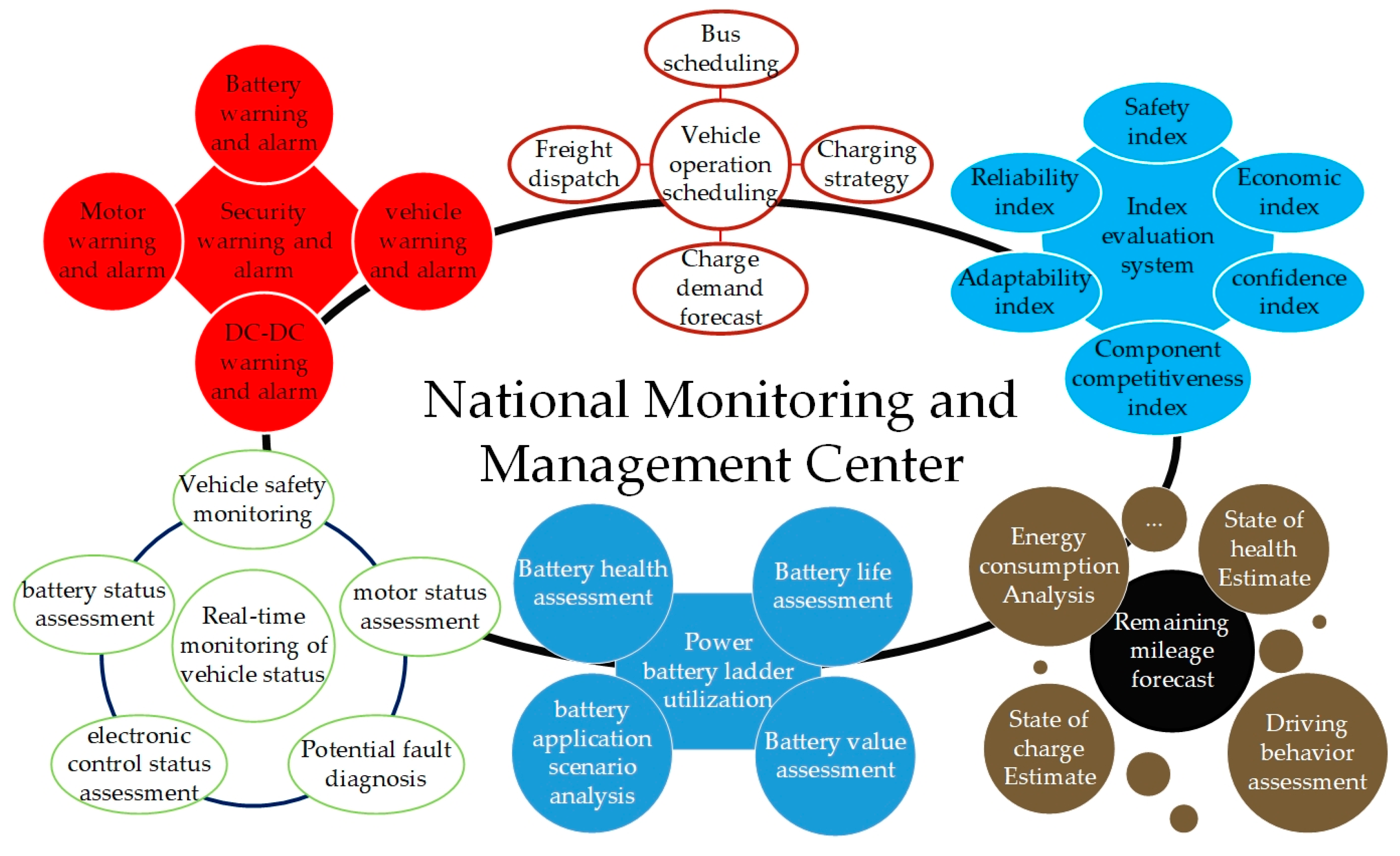

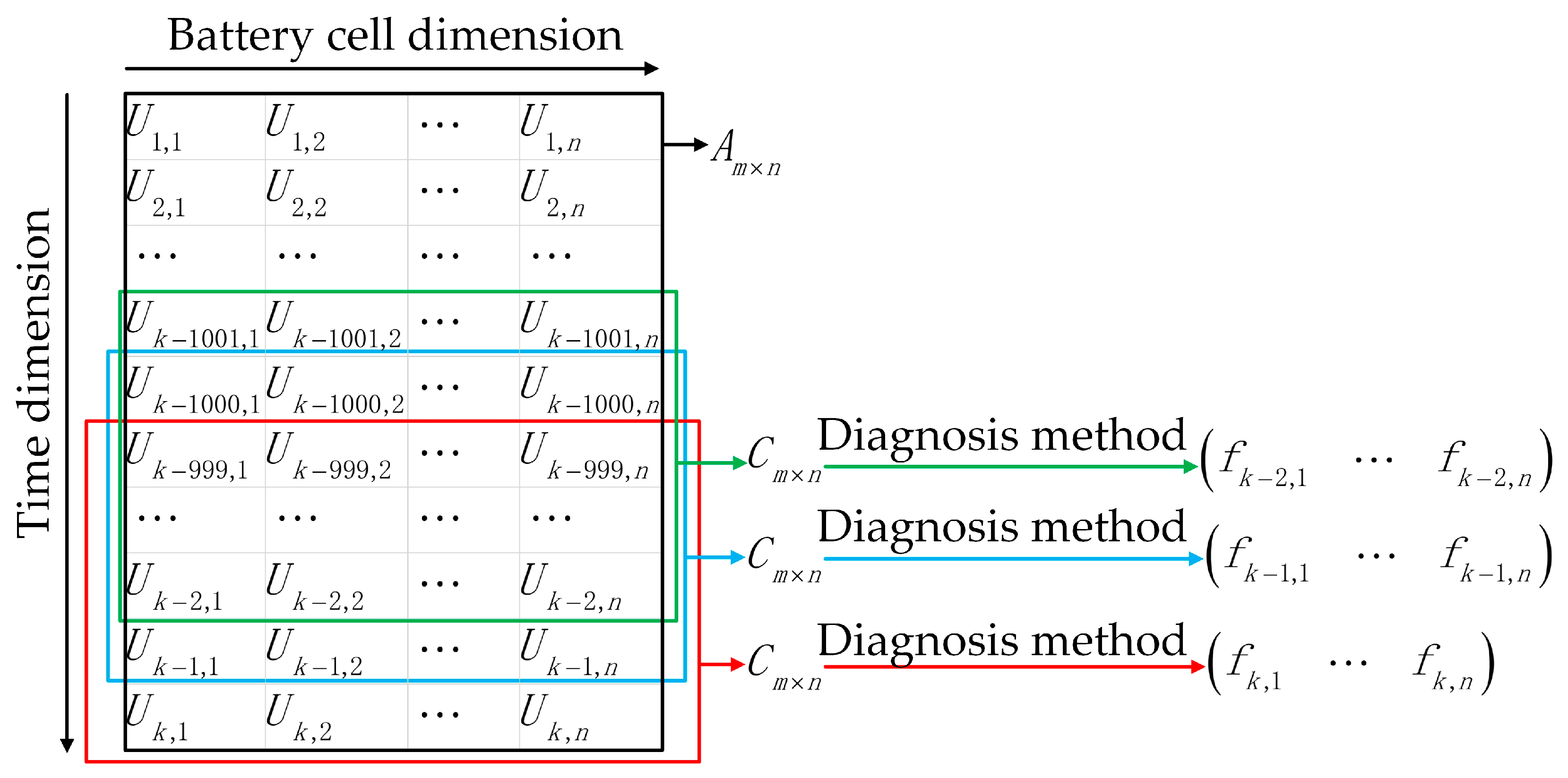
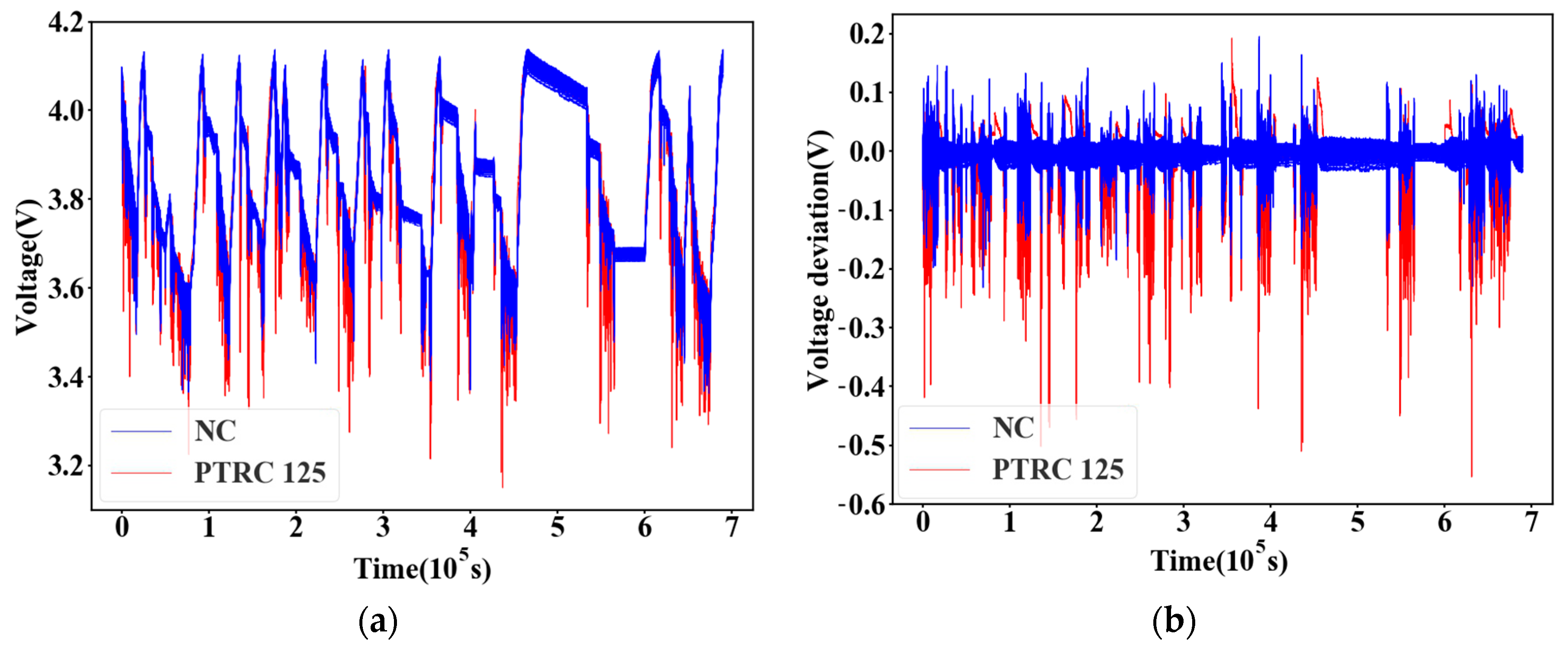
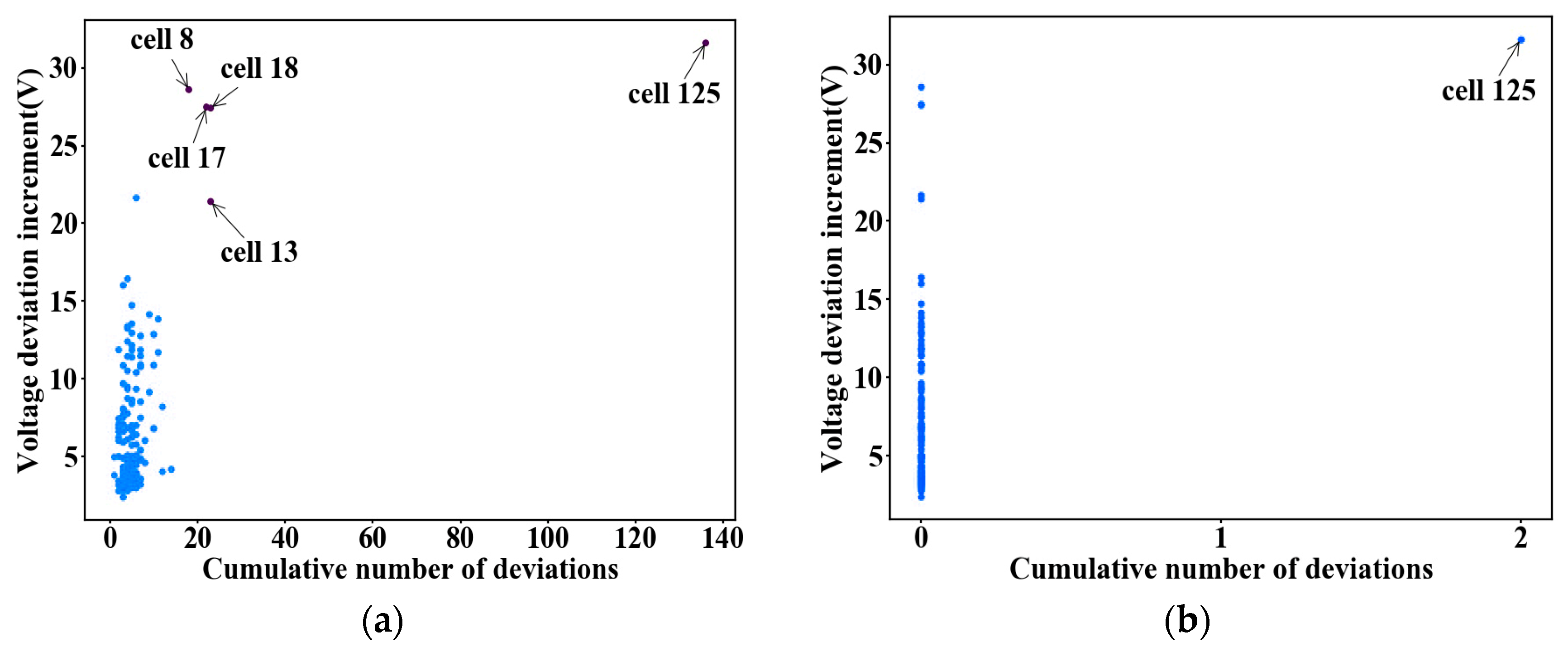
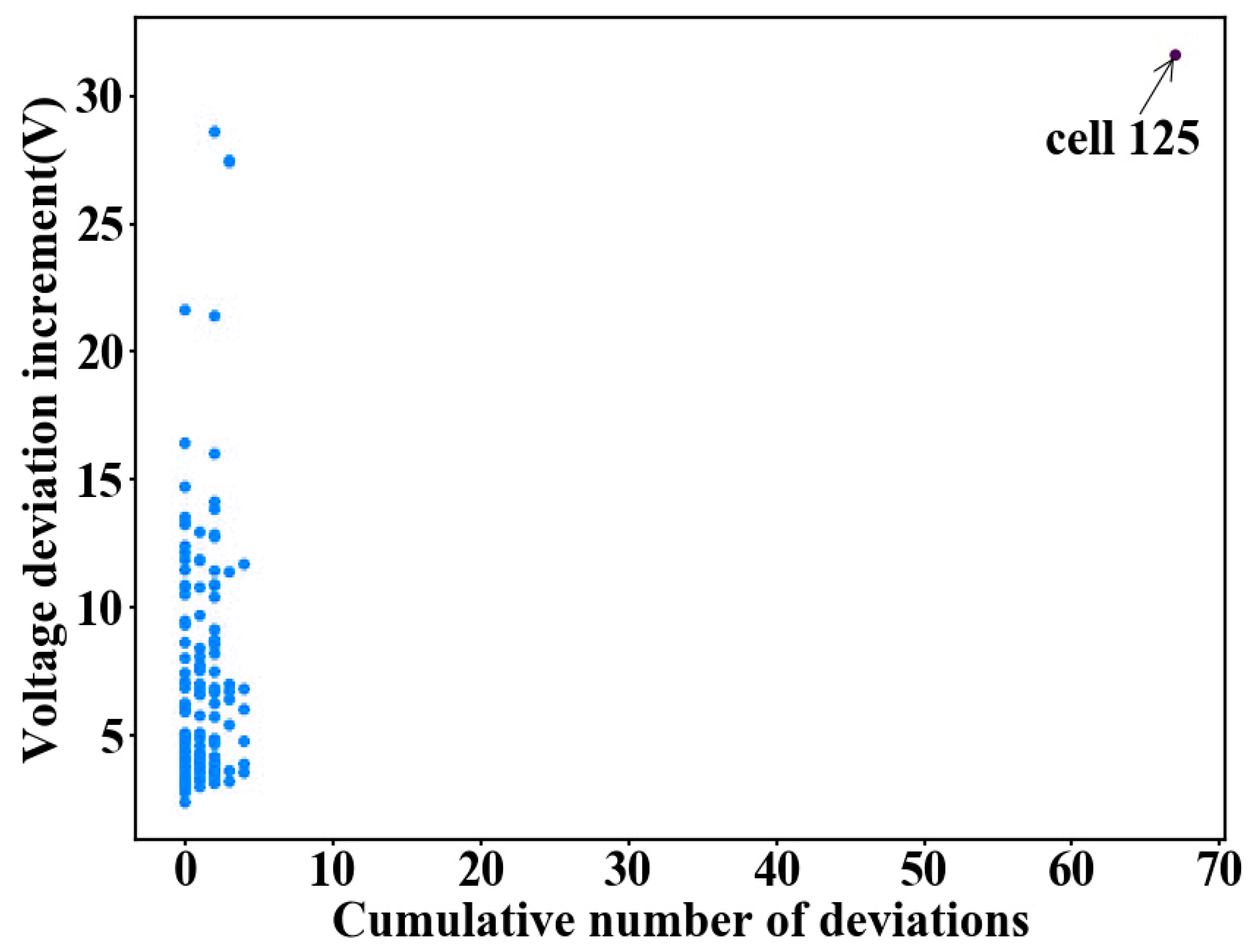
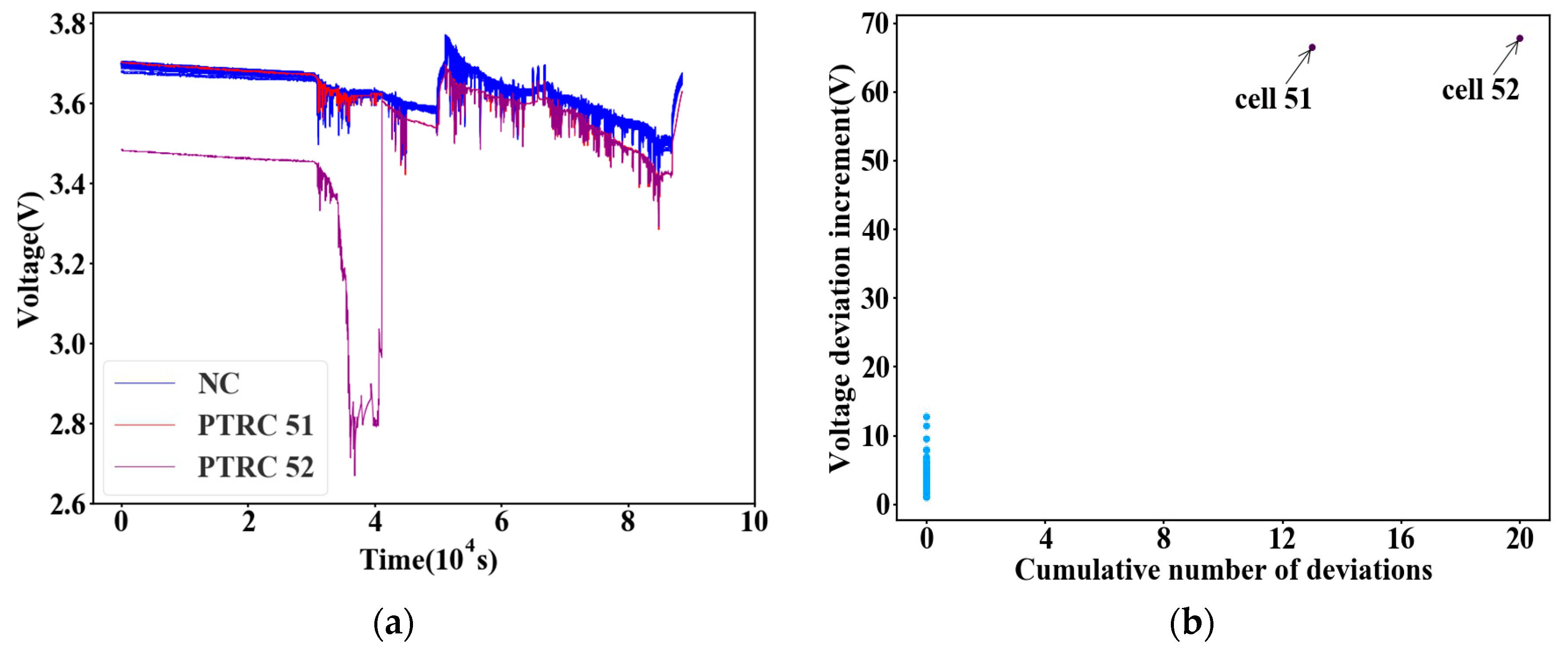
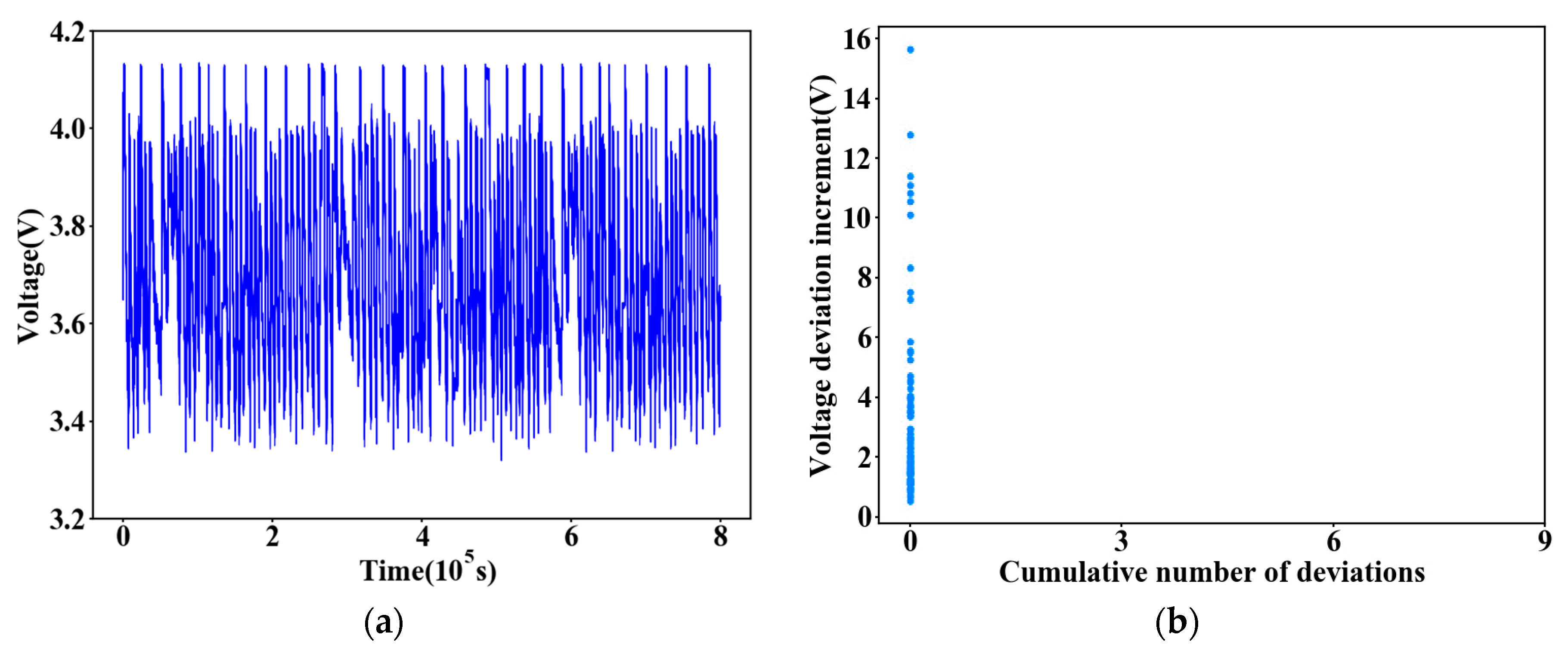


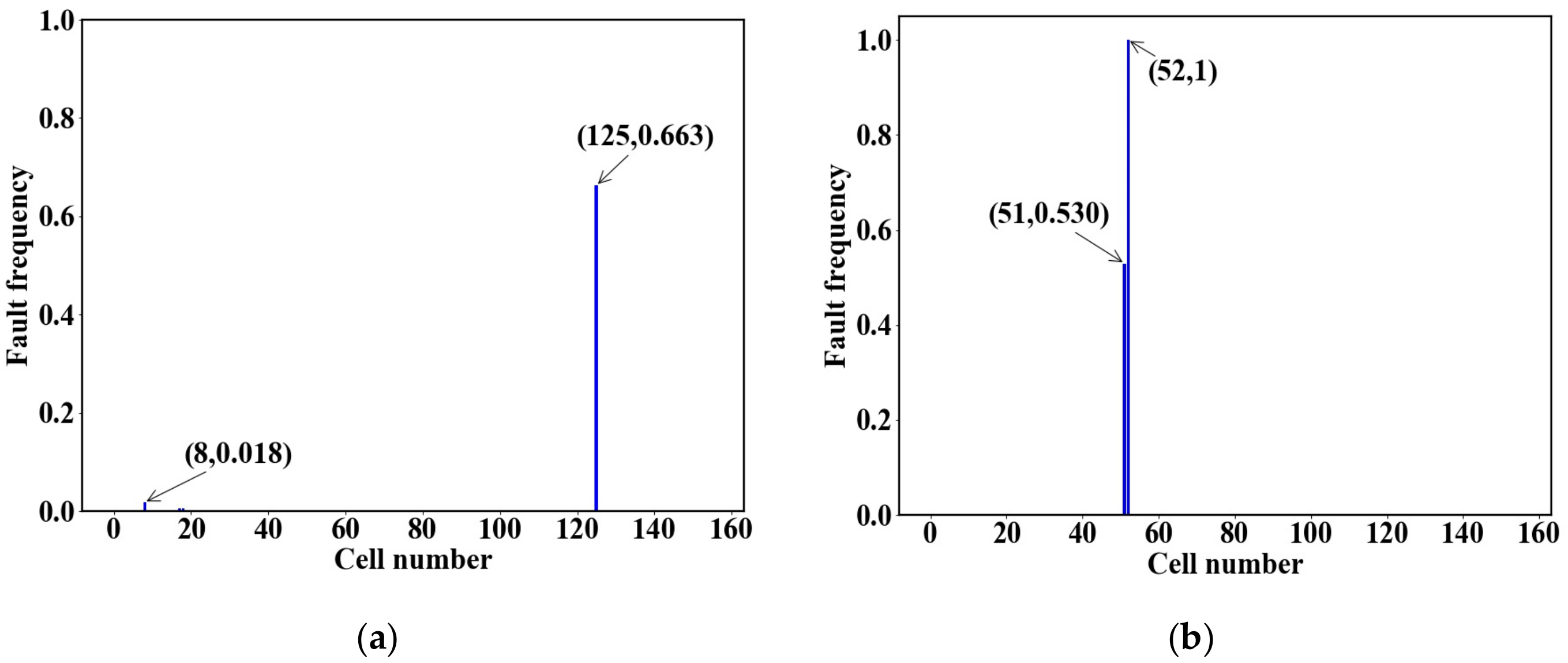
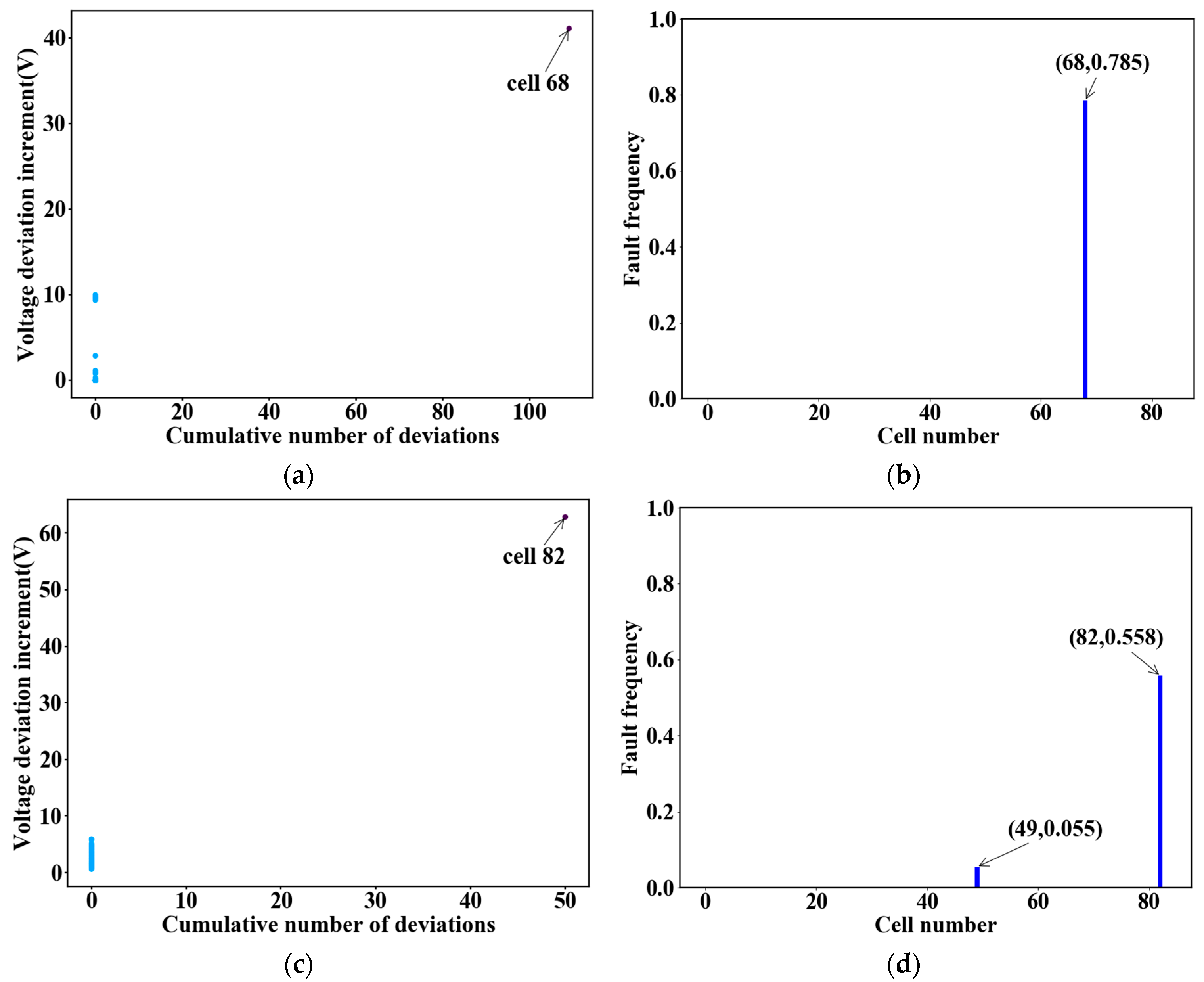
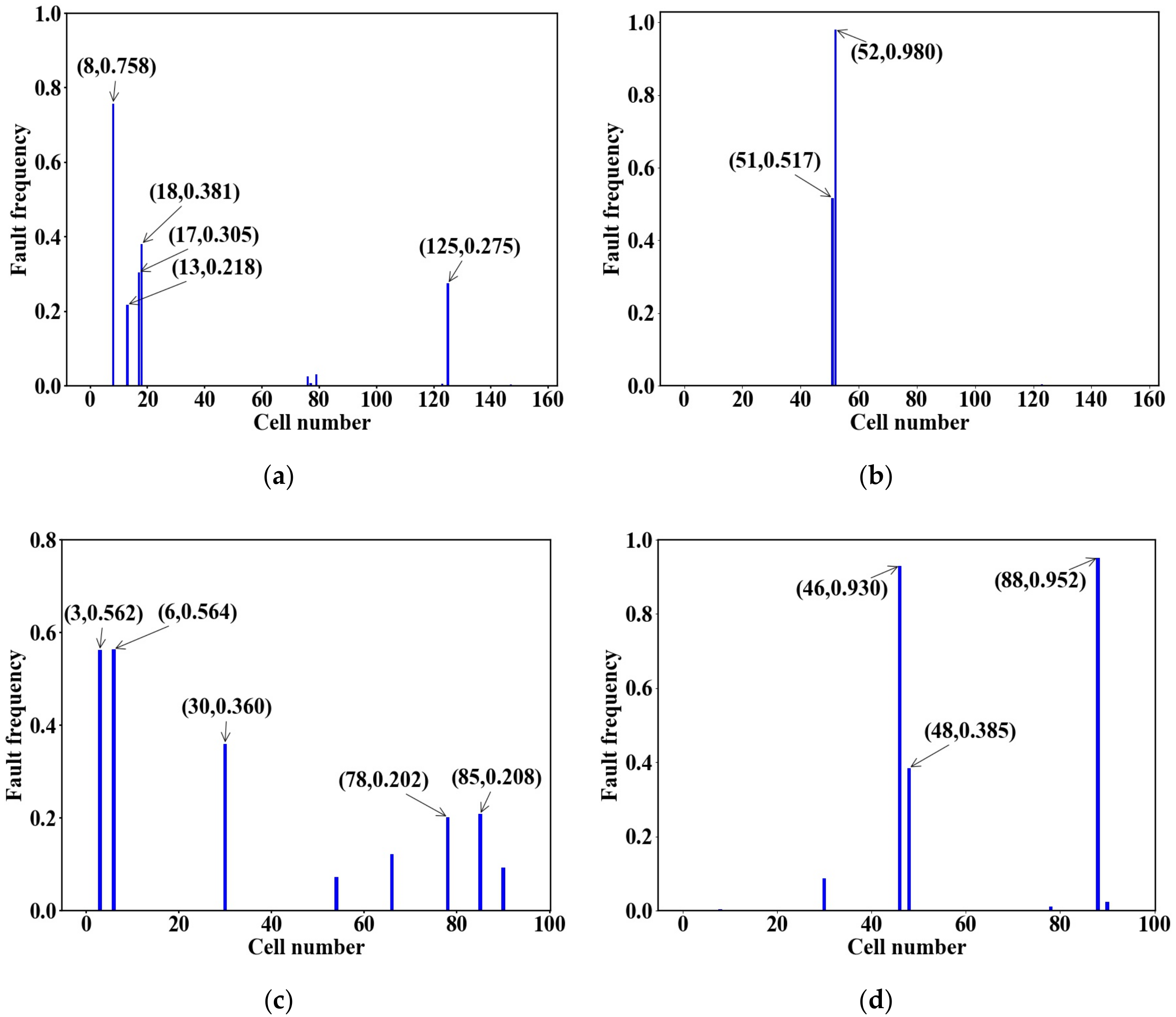
© 2019 by the authors. Licensee MDPI, Basel, Switzerland. This article is an open access article distributed under the terms and conditions of the Creative Commons Attribution (CC BY) license (http://creativecommons.org/licenses/by/4.0/).
Share and Cite
Li, D.; Zhang, Z.; Liu, P.; Wang, Z. DBSCAN-Based Thermal Runaway Diagnosis of Battery Systems for Electric Vehicles. Energies 2019, 12, 2977. https://doi.org/10.3390/en12152977
Li D, Zhang Z, Liu P, Wang Z. DBSCAN-Based Thermal Runaway Diagnosis of Battery Systems for Electric Vehicles. Energies. 2019; 12(15):2977. https://doi.org/10.3390/en12152977
Chicago/Turabian StyleLi, Da, Zhaosheng Zhang, Peng Liu, and Zhenpo Wang. 2019. "DBSCAN-Based Thermal Runaway Diagnosis of Battery Systems for Electric Vehicles" Energies 12, no. 15: 2977. https://doi.org/10.3390/en12152977
APA StyleLi, D., Zhang, Z., Liu, P., & Wang, Z. (2019). DBSCAN-Based Thermal Runaway Diagnosis of Battery Systems for Electric Vehicles. Energies, 12(15), 2977. https://doi.org/10.3390/en12152977





